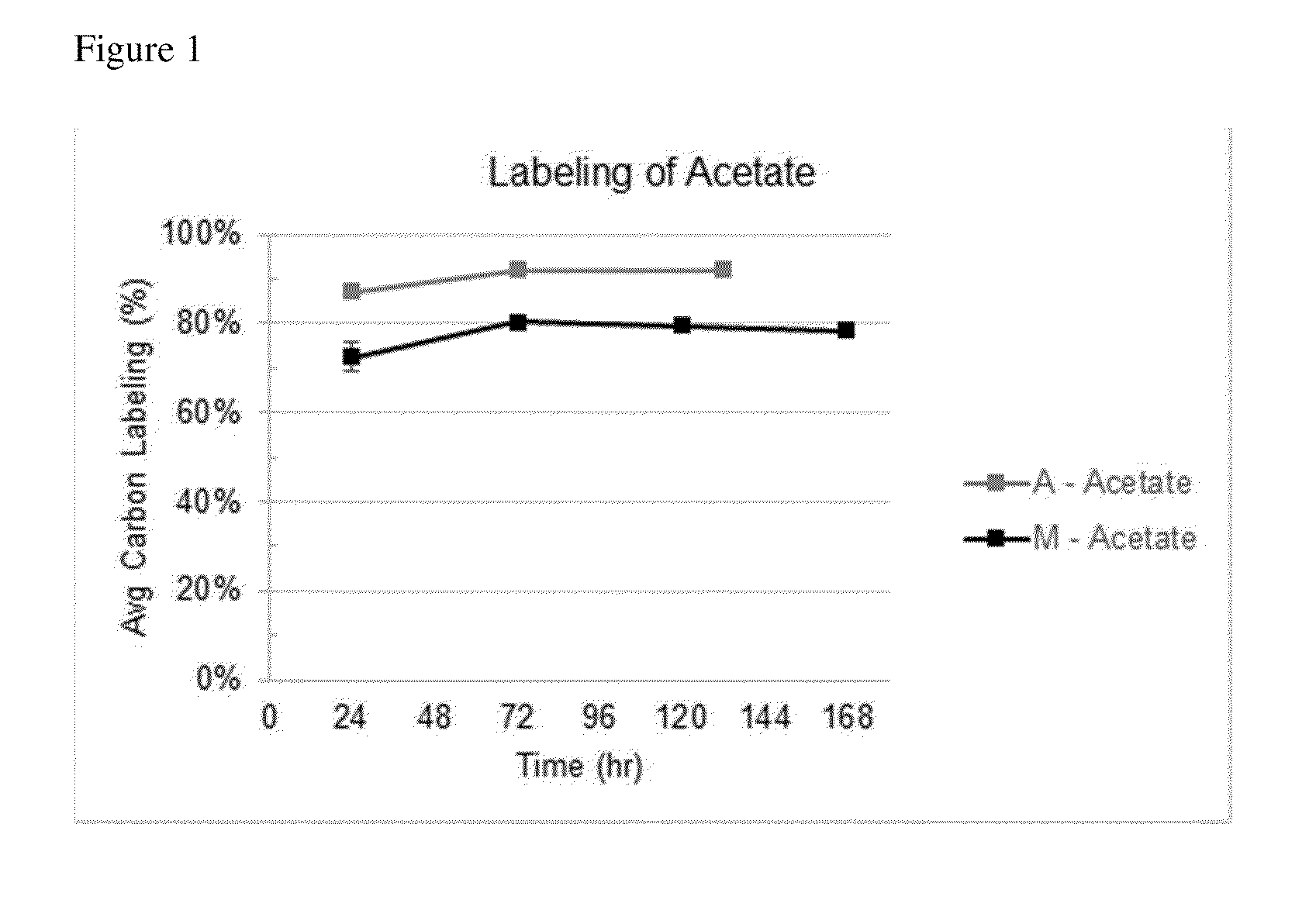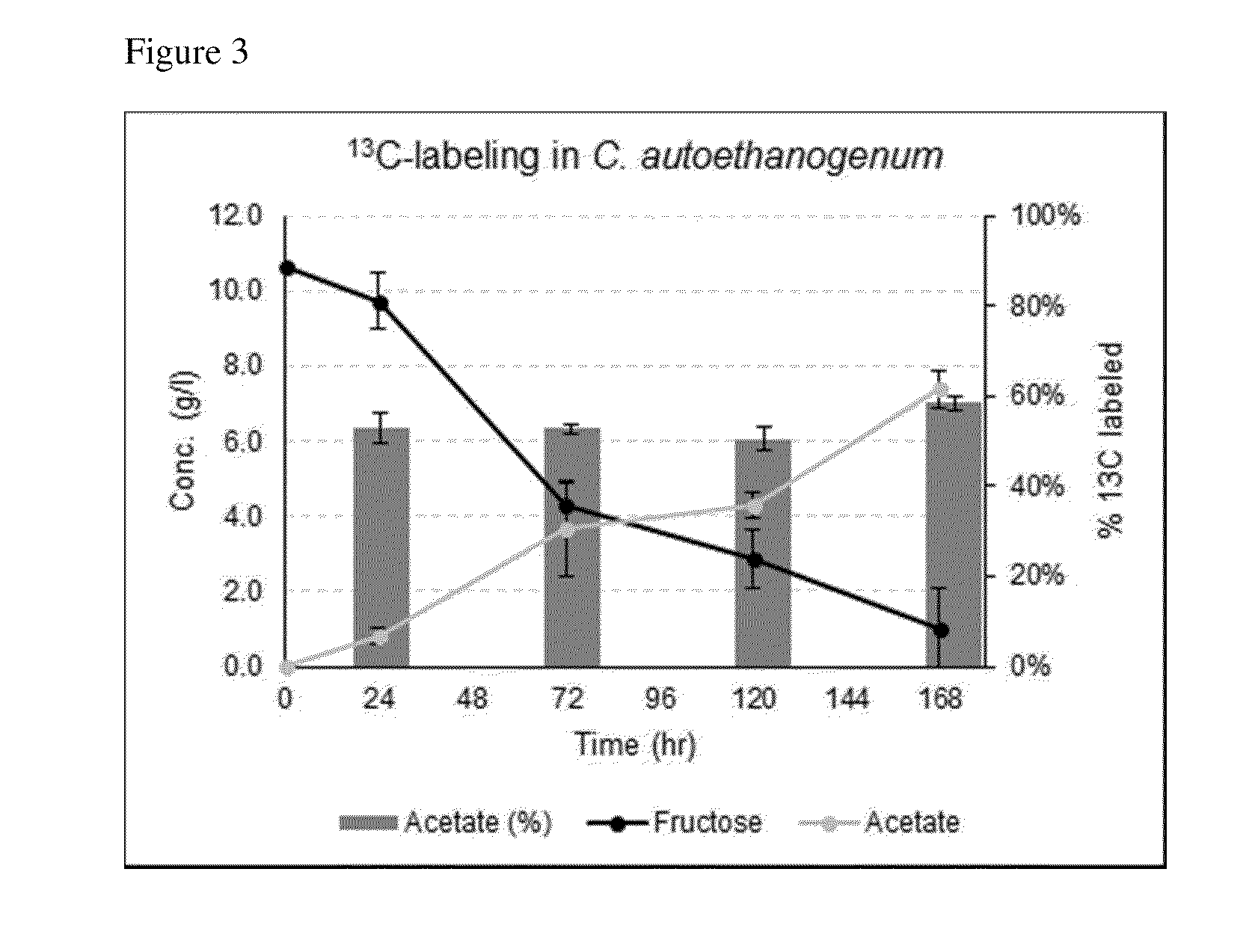Mixotrophic fermentation method for making acetone, isopropanol, butyric acid and other bioproducts, and mixtures thereof
a technology of acetone and isopropanol, which is applied in the direction of fermentation, biofuels, etc., can solve the problems of affecting the conversion rate of feedstocks, the difficulty of conventional methods for maximizing feedstock conversion, and the high production cost of biofuels and certain other bioproducts via microbial fermentation
- Summary
- Abstract
- Description
- Claims
- Application Information
AI Technical Summary
Benefits of technology
Problems solved by technology
Method used
Image
Examples
example 1
[0410]Acetogenic clostridia strain C. ljungdahlii was cultured under three conditions: 5 g / l of fructose (first feedstock) with a N2 headspace at 20 psig (referred to as heterotrophic fermentation), no fructose with a CO (second feedstock) headspace at 20 psig (autotrophic fermentation), and 5 g / l of fructose with a CO headspace at 20 psig (mixotrophic fermentation). Three biological replicates were prepared, grown at 37° C. and shaken at 225 rpm. Table 1 shows the metabolite profiles and carbon yields achieved. Carbon yield for this experiment is calculated by dividing the total amount of carbon in produced bioproducts by the total amount of carbon metabolized from the first feedstock during fermentation.
TABLE 1Concentration (mM)CarbonHourFructoseAcetateEthanol2,3-butanediolLactateyield5 g / l fructose with N2 headspace027.523.740.290.110.00—4125.368.281.980.130.0067%4919.0616.585.770.190.0065%5610.1929.278.290.360.0062%650.6244.1912.630.630.0064%730.0545.0713.600.660.0065%800.0345.1...
example 2
[0414]Acetogenic clostridia strain C. ljungdahlii was cultured under two conditions: 10 g / l of fructose (first feedstock) with a headspace of the gas mixture of CO, CO2, H2, and N2 (55%, 10%, 20%, 15%, respectively) (second feedstock) at 30 psig (referred to as mixotrophic fermentation) and no fructose with a headspace of the gas mixture of CO, CO2, H2, and N2 (55%, 10%, 20%, 15%, respectively) (second feedstock) at 30 psig (referred to as autotrophic fermentation). Two biological replicates were prepared, grown at 37° C. and shaken at 225 rpm. The CO and CO2 were labeled with 13C, allowing the ability to track the uptake and incorporation of the carbon substrates.
[0415]FIG. 1 shows the percentage of 13C labeling of the metabolite acetate over time in both cultures. Average 13C labeling of acetate for autotrophic (A) and mixotrophic (M) cultures between two biological replicates is shown. For the mixotrophic cultures, fructose was never depleted over the time sampled. The final conc...
example 3
[0417]The test of Example 1 was repeated using the acetogenic clostridia strain C. autoethanogenum. Table 2 shows the metabolite profiles and carbon yields.
[0418]Similar to the first example, the cultures with both fructose and a CO headspace had greater carbon efficiencies, indicating gas consumption. In addition, the mixotrophic cultures produced greater amounts of 2,3-butanediol. Compared to the pure gas culture, the mixotrophic culture produced bioproducts at a much faster rate and produced less acetate, relative to other bioproducts.
TABLE 2Concentration (mM)CarbonHourFructoseAcetateEthanol2,3-butanediolyield5 g / l fructose with N2 headspace027.556.713.460.00—8426.899.154.740.00120%9423.4312.697.140.38 77%1203.8042.3923.840.79 80%1700.0046.7725.920.96 77%5 g / l fructose with CO headspace024.627.083.810.19—5323.759.116.260.19170%5822.3510.6210.090.36149%6320.7312.6914.250.64145%6817.3715.6725.451.51151%779.7843.7727.774.68156%843.9869.2020.785.18144%940.0079.8621.545.55137%CO heads...
PUM
 Login to View More
Login to View More Abstract
Description
Claims
Application Information
 Login to View More
Login to View More - R&D
- Intellectual Property
- Life Sciences
- Materials
- Tech Scout
- Unparalleled Data Quality
- Higher Quality Content
- 60% Fewer Hallucinations
Browse by: Latest US Patents, China's latest patents, Technical Efficacy Thesaurus, Application Domain, Technology Topic, Popular Technical Reports.
© 2025 PatSnap. All rights reserved.Legal|Privacy policy|Modern Slavery Act Transparency Statement|Sitemap|About US| Contact US: help@patsnap.com



